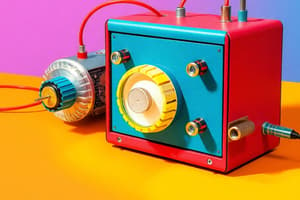Podcast
Questions and Answers
Which of the following is true about an electromechanical device?
Which of the following is true about an electromechanical device?
- It can only convert thermal energy to mechanical energy
- It cannot convert any form of energy
- It can only convert electrical energy to mechanical energy
- It can convert mechanical energy to electrical energy (correct)
What is the function of a transducer?
What is the function of a transducer?
- It moves or controls some mechanism
- It provides usable output response to a specific input measured
- It converts one form of energy into another form (correct)
- It converts electrical energy into mechanical energy
What does an actuator do?
What does an actuator do?
- Converts mechanical energy into electrical energy
- Moves or controls some mechanism (correct)
- Provides output with respect to a specific physical quantity
- Detects or measures a physical property and records it
What type of energy does a DC motor convert?
What type of energy does a DC motor convert?
What is the primary function of a sensor?
What is the primary function of a sensor?
Which type of energy does a DC motor convert?
Which type of energy does a DC motor convert?
What is the primary function of a transducer?
What is the primary function of a transducer?
What is the difference between a sensor and an actuator?
What is the difference between a sensor and an actuator?
Which statement about electromechanical devices is true?
Which statement about electromechanical devices is true?
What is the function of an actuator?
What is the function of an actuator?
Flashcards
Transducer
Transducer
A device that converts one form of energy into another form.
DC motor
DC motor
A device that converts electrical energy into mechanical energy.
Sensor
Sensor
A device that detects or measures a physical property and records it.
Actuator
Actuator
A device that moves or controls a mechanism in response to a signal.
Signup and view all the flashcards
Electromechanical device
Electromechanical device
A device that converts mechanical energy into electrical energy.
Signup and view all the flashcards
Difference between a sensor and an actuator
Difference between a sensor and an actuator
Sensors provide output in response to input, while actuators control a mechanism in response to a signal.
Signup and view all the flashcards
True statement about electromechanical devices
True statement about electromechanical devices
They convert mechanical energy to electrical energy.
Signup and view all the flashcards
Function of an actuator
Function of an actuator
Moves or controls a mechanism in response to a signal.
Signup and view all the flashcards
What is true about an electromechanical device?
What is true about an electromechanical device?
It converts mechanical energy to electrical energy
Signup and view all the flashcards
What is the function of a transducer?
What is the function of a transducer?
It converts one form of energy into another form.
Signup and view all the flashcardsStudy Notes
Electromechanical Devices
- An electromechanical device is a device that uses both electrical and mechanical systems to perform a function.
Sensors and Actuators
- A sensor detects and measures physical or environmental parameters, such as temperature, pressure, or light, and converts them into electrical signals.
- An actuator uses electrical energy to produce mechanical energy, such as movement or force, to perform a specific task.
Transducers
- A transducer converts one form of energy to another, such as converting electrical energy into mechanical energy or vice versa.
DC Motors
- A DC motor converts electrical energy into mechanical energy.
Functions and Differences
- The primary function of a sensor is to detect and measure physical or environmental parameters and convert them into electrical signals.
- The primary function of an actuator is to use electrical energy to produce mechanical energy, such as movement or force, to perform a specific task.
- The primary function of a transducer is to convert one form of energy to another.
- The main difference between a sensor and an actuator is that a sensor detects and measures parameters, while an actuator produces mechanical energy to perform a task.
Studying That Suits You
Use AI to generate personalized quizzes and flashcards to suit your learning preferences.




